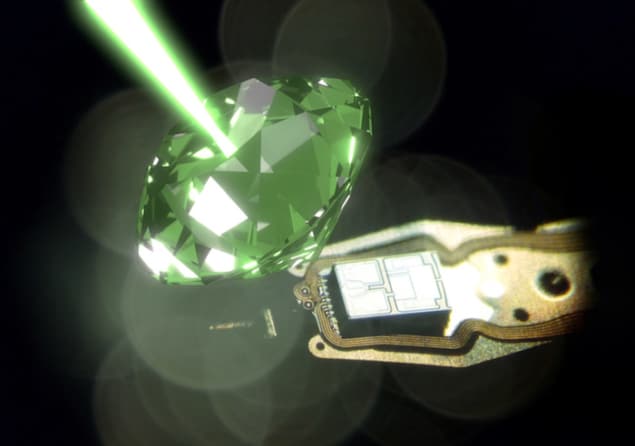
A nitrogen-vacancy (NV) defect in diamond has been used to create a magnetometer that can measure the broadband magnetic fields generated by hard-disk write heads. The work was done by researchers in Germany and the UK who have shown that a single NV can detect the oscillating and static magnetic fields associated with write heads at nanometre resolution. The new work could help further miniaturize hard-disk drives, thereby increasing their data-storage capacity.
“The hard-disk industry currently has no established sensors that can resolve the magnetic field of write heads on the scale of 5–10 nm,” explains team-member Ingmar Jakobi of the University of Stuttgart. “This is a serious impediment for developing these devices, which will carry the biggest share of data in the ever-growing digital world.”
The NV defect in diamond offers a solution to this problem because it comprises a single electron spin that is highly isolated from its immediate surroundings. This spin is essentially a tiny magnet that could be used to detect changes in a magnetic field over nanometre distances.
Brighter light
Now, a team led by Jörg Wrachtrup at the University of Stuttgart has shown that a single NV can act as an atomic-sized magnetic sensor that can detect the broadband magnetic fields produced by the head of a hard-disk writer. NV centres give off red fluorescent light when illuminated with green light and the intensity of this red light is affected by the presence of an external magnetic field. “Depending on the spin state of the NV defect, we see darker or brighter fluorescence and this allows us to focus on a single defect near a write head using a confocal microscope and determine its spin state,” explains Jakobi.
The spin also has a Zeeman interaction, whereby its energy levels split in the presence of a magnetic field. This means that the strength of an applied static field can be determined by doing magnetic-resonance measurements. Furthermore, the strength of an oscillating field can be determined from measuring spin transition rates.
Because the NV electron spin is more or less confined to a single site of the diamond lattice, the volume that the sensor probes is just a few cubic angstroms. As a result, the spatial resolution achieved by the team depends on its ability to accurately position the NV – as well as how far the NV is from the surface of the diamond.
Shallow NVs
To test their NV-based sensor, the researchers scanned a hard-disk head – which is about 1 mm in size – over the surface of a diamond sample containing NVs. The critical part of the write head, the write pole, is only around 100 nm in size and was positioned near the NVs. “We could first observe how the fluorescence response of NVs change with the applied field direction,” says Jakobi. “It is at its brightest when the field is aligned with the crystal axis along which the defect is oriented and this is therefore a good way to measure the field’s orientation.”
Using the NV centre, the team was able to measure magnetic fields that were oscillating at frequencies approaching one gigahertz. It could also measure millitesla changes in magnetic-field strength over nanometre distances.
The team, which includes researchers from Seagate Technology in Londonderry and Element Six in Oxford, says that the NV defect could be developed into a powerful R&D tool for artificial nano-magnetic devices. “In the hard-disk industry especially, there is huge demand for increased areal-density capacity – that is, smaller bits on the recording medium and therefore smaller structures to read and write data onto,” explains Jakobi. “An atomic-scale NV sensor could therefore play a critical role in helping to miniaturize recording heads and meeting this demand.”
Quality control
Quality-control sensors for production lines are also a possibility, he believes. At the moment, writers are only tested in a finished hard-disk, but the new technique could allow for tests at the wafer stage, early on in the production process, and hence reduce manufacturing costs.
Pengbo Li at Xi’an Jiaotong University in China, who was not involved in this study, says that the new study is “very interesting and important”. “It provides a unique tool for precisely measuring the magnetic fields on the nanoscale and will advance the field of high-precision sensors based on NV centres.”
Wrachtrup and colleagues report their experiments in Nature Nanotechnology.
- A version of this article first appeared on nanotechweb.org



